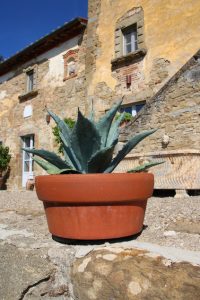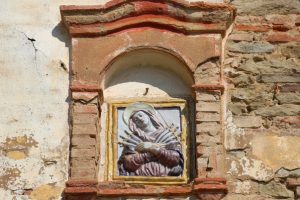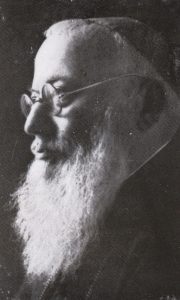By Philip Hampden-Smith
 For four years my wife Chrissy Hampden-Smith and I crisscrossed Italy in search of our perfect home. After abandoning searches in Amalfi (too much traffic) and Lake Como ( too damp winters ) we discovered Cortona. Then one evening in June 2017 we saw, and fell in love with, “Il Padronale “only two miles outside the walls of the town. As the sun set on the mellow and time worn stone of its facade we knew our search was over.
For four years my wife Chrissy Hampden-Smith and I crisscrossed Italy in search of our perfect home. After abandoning searches in Amalfi (too much traffic) and Lake Como ( too damp winters ) we discovered Cortona. Then one evening in June 2017 we saw, and fell in love with, “Il Padronale “only two miles outside the walls of the town. As the sun set on the mellow and time worn stone of its facade we knew our search was over.
The oldest part of the house, the central tower, goes back to the 15th century, its original incarnation being a watchtower protecting Tuscany’s flank with Papal Umbria. It became a house when two wings to the left and right of the tower were added in 1771 by the Tommasi family, whose coat of arms adorns a large stone set into the wall above the main door. The Tommasi theme continues with their weathered crest appearing regularly on the capstones of many of the beautiful stone mullioned windows to the front of the building. In addition to the Tommasi connection, the front of the house displays a magnificent 17th century ceramic plaque from the area of Doccia of Our Lady Of Seven Sorrows. Our Lady of Seven Sorrows has its origins in Tuscany when seven Tuscan youths founded the Servite Order and set up the Seven Sorrows as the principal devotion of their order. It is a beautiful piece of work which still sits in its original niche.
 To the left of the niche that holds the Madonna, there is another much simpler plaque in marble that catches the eye…striking in both its whiteness and its simplicity. Etched into the plain white marble are the following words. “In questa casa nacque Mons Paolino Tribbioli che lasciò orme indelebili Di Cappuccino Missionario in India e per 43 anni Vescovo Di Imola. 13:12:1868 – 12:5:1956. Nel Centenario della sua nascita .” (In this house was born Monsignor Paolino Tribbioli who left indelible traces of the Capuchin Mission in India and for 43 years Bishop of Imola 13/12/1868 – 12/4/ 1956. In the Centennial of his birth.)
To the left of the niche that holds the Madonna, there is another much simpler plaque in marble that catches the eye…striking in both its whiteness and its simplicity. Etched into the plain white marble are the following words. “In questa casa nacque Mons Paolino Tribbioli che lasciò orme indelebili Di Cappuccino Missionario in India e per 43 anni Vescovo Di Imola. 13:12:1868 – 12:5:1956. Nel Centenario della sua nascita .” (In this house was born Monsignor Paolino Tribbioli who left indelible traces of the Capuchin Mission in India and for 43 years Bishop of Imola 13/12/1868 – 12/4/ 1956. In the Centennial of his birth.)
So just who was Paolo Tribbioli and what imprint did he leave behind on this Earth?
 Paolino Giovanni Tribbioli was born on the 13th of December, 1868, into an illiterate farming family who worked the land under a feudal contract for a local landowner. Italy was a new creation then, not even a decade old. The world was changing. Paolino’s far-sighted father, understanding the opportunity that the church would provide his young son, enrolled him into the Capuchin College in Montevarchi.
Paolino Giovanni Tribbioli was born on the 13th of December, 1868, into an illiterate farming family who worked the land under a feudal contract for a local landowner. Italy was a new creation then, not even a decade old. The world was changing. Paolino’s far-sighted father, understanding the opportunity that the church would provide his young son, enrolled him into the Capuchin College in Montevarchi.
Young Paolino was a very good student. He did well and was eventually christened Paolino da Cortona in 1884, and in 1891 he was ordained in Siena. With his flair for organisation and his ability to attract people to him he was sent to India in October of that year and did not return to Italy until 1898. His time in India was largely focused on Agra, where after three years he became the Vicar or “Vicariò” of the Catholic Cathedral. This was an astonishing achievement for someone both so young and so new to India.
A severe bout of malaria saw him evacuated to the foothills of the Himalayas and border with Tibet. As he recuperated he used his time to study English in which he became fluent.
 Regaining his health, he returned to Agra and eventually to Italy, where he soon became the Secretary General for the Capuchin Order who had wanted a talented English speaker, which Tribbioli now was.
Regaining his health, he returned to Agra and eventually to Italy, where he soon became the Secretary General for the Capuchin Order who had wanted a talented English speaker, which Tribbioli now was.
 Tribbioli continued to dream of a return to India. But it was not to be. Meanwhile, his work ethic and his far-sightedness had attracted the attention of Pope Pius X, who asked him to change course and in 1913 he was consecrated as the Bishop of Imola , a post he held for a record 43 years until his death in 1956 . Pope Pius also personally gave him the title of Monsignor in recognition of his works and the advice he had rendered to Pius during his period as Pope.
Tribbioli continued to dream of a return to India. But it was not to be. Meanwhile, his work ethic and his far-sightedness had attracted the attention of Pope Pius X, who asked him to change course and in 1913 he was consecrated as the Bishop of Imola , a post he held for a record 43 years until his death in 1956 . Pope Pius also personally gave him the title of Monsignor in recognition of his works and the advice he had rendered to Pius during his period as Pope.
Well-known and respected in the church he became known by all as, “Il Martire della Pazienza “ or “The Martyr to Patience” – not a bad epitaph for a farm boy from Cortona. One wonders if Bishop Tribbioli ever returned to his boyhood home to look up again at the Lady of the Seven Sorrows to contemplate a life well lived? We shall never know.
